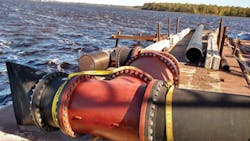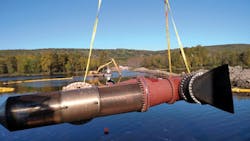| Proco rubber check valves work automatically for pipelines to provide water for snow-making as well as divert excess stormwater during spring to fall. |
Design Challenges
Planning a reversing pipeline presented several design challenges, said Jeff Ledin, senior professional engineer at Short Elliott Hendrickson Inc. (SEH), the project’s engineer. Water used for making snow is pumped at up to 6,000 gpm. Stormwater then flows out of the pipeline at up to 20 cfs. To allow water to flow in both directions, a system using elastomeric check valves was designed.
“This pair of valves was a critical component of the project,” Ledin said. “At the end of the pipeline we have to get water to go through a T-fitting in two different directions. In one scenario, water is going out; in another scenario, water is coming in.”
At the end of the 36-foot pipeline, the planning team decided to use a Proco ProFlex™ Style 710 duckbill check valve and a Proco ProFlex™ Style 780 wafer style in-line rubber check valve. The valves work automatically, with water flowing out through the duckbill check valve and in through the wafer-style check valve. This system was placed in 20 feet of water about 800 feet from the riverbank, making it only accessible to divers and marine construction crews. Using a product that was reliable and required no maintenance was crucial, Ledin said. Getting divers to do inspection or maintenance work in the murky water would be expensive and labor-intensive.




